#sasameyuki
Note
In your poll I voted for queer-coded Yukiko with more hope in my heart than certainty, realising I was going to have to reread "Sasameyuki" to hunt for clues. >.> At length, I did. Lesbian Yukiko, I just don't see in the text (though if you do, I'd love to hear more). Ace Yukiko feels plausible — but then, asexuality is outwardly indistinguishable from being a Nice Girl from a Good Family, so I'm not rushing to judgment there. But may I posit Autistic Yukiko—? Fastidious about her food, socially maladroit and so shy around strangers that she can barely speak, stubbornly attached to her same place, her same people, her same clothes (i.e. she's still wearing the kimono of her youth), content to let the rest of life pass her by while she continues year after year in her familiar routines — and, as much as possible, avoids the telephone. *sympathetic shudder*
I'm bogged down in the middle of a reread myself right now (I've read Sasameyuki in a few weeks to a month; I've read Sasameyuki in a few days; this time I'm taking over a year) and I remember a lot of what I read as the lesbian-ish coding coming later on in the novel, so I'll have to get back to you on that. Aro-ace Yukiko is a totally solid read too; I believe it's the sense that @carys-the-ninth got when she read it.
Having said that, YES YUKIKO IS AUTISTIC. You see her! You understand her! The phone scene is a great example (just as it's so key to understanding her in general), but I think it shows up even in otherwise difficult-to-explain moments like her apparently thinking it's better for Taeko to marry Okubata than to marry Itakura, from a standpoint of genuine concern for Taeko's wellbeing. That's what the (metaphorical) social skills book said would constitute a good life outcome for Taeko. Why won't Taeko defer to the social skills book??
5 notes
·
View notes
Text
Analysis of BSD Tanizaki (Character and Theories) in Reference to Real Life Tanizaki Jun’ichirou
By popular demand of (1) person in the comments of a post I’ve made briefly touching on this subject, I have compiled all of my thoughts on the portrayal of Tanizaki Jun’ichirou—and by extension, Naomi—in Bungou Stray Dogs in reference to the works of the real life Tanizaki Jun’ichirou-sensei (who I’ll be calling Tanizaki-sensei to differentiate from his fictional counterpart). Disclaimer that I don’t have the academic background to write as an expert on this subject. I will be citing all of my sources in the text.
Tanizaki-sensei (1886-1965) was an author who was well known for writing about sexual obsession and fetishes, and the exploration of Japanese versus Western culture in his works. His female characters were particularly reputable for having strong personalities (drawing upon the dofuku - “poisonous woman” or femme fatale troupe), and frequently fulfilled the domineering role in sadomasochistic relationships with men. This recurring theme is most likely the basis for Tanizaki and Naomi’s relationship in Bungou Stray Dogs.

In a similar vein, motifs such as dreaming, delusions, and fantasies (oftentimes of the erotic nature) frequently appear in Tanizaki-sensei’s works. This could be the basis for Tanizaki’s illusion projection ability, “Light Snow”, which is named after Tanizaki-sensei’s great novel, Sasameyuki (1948), also known as The Makioka Sisters, the title of the English translation, which was changed due to the nuance of the original title being difficult to convey in English.
Going on a slight tangent here, Tanizaki-sensei also wrote a handful of works depicting blindness, such as A Portrait of Shunkin (1933) and A Blind Man’s Tale (1931). In these works, blindness can be interpreted as a metaphor for blind devotion and obsessive worship of one’s love interest, even to the point of martyrdom. For example, in A Portrait of Shunkin (1933), the character Sasuke destroys his own eyesight for his vain mistress, who did not want to be seen after an incident destroys her beauty. Tanizaki and Naomi’s deep affection for each other is reminiscent of these themes (Tanizaki’s willingness to throw away his morals for Naomi, Naomi taking gunfire in Tanizaki’s place).
Unfortunately, we aren’t given any other concrete pieces of information about Tanizaki or Naomi that can be reliably connected to something in regards to the real life author...
The Unreliable Narrator
Which brings me to my first point in regards to fan theories surrounding Tanizaki and Naomi. I have mentioned in previous posts that Tanizaki’s descriptions of himself oftentimes contradict what we are actually shown (not good for combat, cowardly and average, etc), which means that Tanizaki is an unreliable narrator of his own backstory. To what extent he is unreliable, we can only speculate.
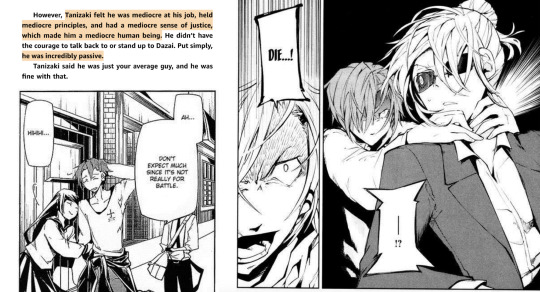
However, the theory that Tanizaki cannot be trusted to tell the truth about himself is supported by the real life counterparts’ use of this narrative device in his works. A journal article by The Columbia Companion to Modern East Asian Literature explains that “[Tanizaki-sensei’s stories] are often told by a personified and thus not necessarily reliable narrator,” which is especially evident in both Naomi (1925), a post-hoc account of the protagonist’s marriage, and The Key (1956), two juxtaposed diaries of a married couple.
Since Tanizaki-sensei tended to employ biased narrators in his stories, Tanizaki being an unreliable narrator of his own story would be a clever nod to his real life counterpart.
Moving on, the theory that Tanizaki may be lying about himself opens a world of possibilities regarding what the truth actually is. One popular fan theory is that Naomi is actually an illusory ability construct created by Tanizaki’s ability “Light Snow”.
Sculpting the Ideal Woman
Another recurring theme in Tanizaki-sensei’s works is a character’s desire to “shape” a woman into their vision for what that woman should be. This takes a variety of forms: in The Tattooer (1910), the protagonist “[desires] to create a masterpiece on the skin of a beautiful woman”, thus transforming her into a “real beauty”. In Aguri (1922) the protagonist dreams that “he would adorn [her] with jewels and silks. He would strip off that shapeless, unbecoming kimono... and then dress her in Western clothes”. The desire to make a woman more “Western” is also apparent with the protagonist Joji’s intent in Naomi (1925), the book that BSD Naomi is named after.
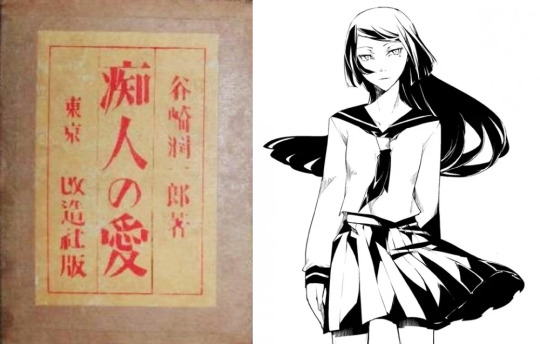
However, I must caution that BSD Naomi is actually quite different from how the character of Naomi is in the original novel; BSD Naomi is kinder to the people around her, and isn’t portrayed as selfish or manipulative. The two Naomis’ do share their penchant for mischief, and their bold, tomboyish personalities, as well as their surprising intelligence and aptitude for planning.
Back to the main topic: other BSD fans have pointed out that this theme of “making Naomi” in the novel supports the theory that BSD Naomi was created by Tanizaki’s ability. Considering that this pygmalion-like desire also appears in many other stories written by Tanizaki-sensei, the connection makes sense. Notably a role reversal between the “sculptor” and the “sculpture” always takes place in such stories.
Losing Control
In Tanizaki-sensei’s stories, female characters who are transformed to fit a man’s ideal are rarely subservient by the end of the narrative. Instead, the change oftentimes pushes them into a more dominant role, where they are the ones doing the controlling, rather than being controlled. In Naomi (1925), the protagonist narrates that “I forgot my innocent notion of "training" her: I was the one being dragged along, and by the time I realized what was happening, there was nothing I could do about it.” As the alternate title, A Fool’s Love, may suggest, by the end of the book Naomi has made a fool out of the protagonist, having “made careful plans and lured [him] on”, ultimately ending up in a position of power.
This could be indicative of Naomi’s own autonomy as an ability construct: we see her arguing with Tanizaki and defying his instruction, possessing talent and knowledge that Tanizaki does not have, and making decisions independent of Tanizaki’s will. For all intents and purposes, Naomi is no different than a human being.
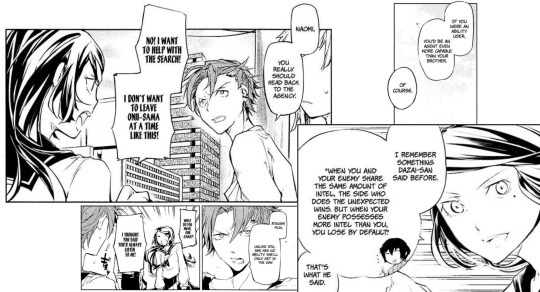
Of course, whether or not this theory will prove correct is a different matter. It should be noted that one variation of this theory speculates that Naomi did exist as a real person, but died in middle school. Unable to cope with the loss, Tanizaki unconsciously created an illusion in her image. This idea is reminiscent of A Portrait of Shunkin (1933), where it is said that in the years after Sasuke’s mistress and lover passed away, “he created a Shunkin quite remote from the actual woman, yet more and more vivid in his mind.” The character Sasuke was said to exaggerate his mistress’ talents to the point that his accounts of her were unreliable, and her passing contributed to his over imagination of her likeliness.
Secret Relationships
Another theory I have seen circulating the fandom is that Naomi and Tanizaki lied about their relationship, telling others that they are siblings in order to cover up their romance. In Naomi (1925), a similar ruse is hatched by the character Naomi, who goes behind her husband Joji’s back and sleeps with other men. Joji discovers this subterfuge from the character Hamada, who confesses, “I didn't know about you at all. Miss Naomi...said you were her cousin.” As such, Tanizaki and Naomi may similarly be lying about the nature of their relationship, which would be a nod to the original novel.
Of course, though I am partial to this theory, since I would be sad if Naomi turned out to be an illusion, I cannot with any confidence claim that it is more likely than the other theory I mentioned regarding her, or any other theories that might be circulating.
Return from the West
Moving on from theories involving Naomi, evidence that supports the theory that Tanizaki will change allegiances from the Armed Detective Agency to the Port Mafia can also be found with his real life counterpart. As I touched on a bit before, Tanizaki-sensei wrote about and was influenced by Western culture and traditions. However, after Tanizaki-sensei moved from Yokohama to the Kansai region in 1926, his fascination dwindled, and he completed works such as Some Prefer Nettles (1929), which “[presented] subtly and effectively the great transformation in Tanizaki's life from a worshiper of the West to a believer in the value of the Japanese heritage” as explained by Donald Keene in “Five Modern Japanese Novelists”.
One such work that compared Western and Japanese culture is “In Praise of Shadows” (1933), which associated shadows with traditional Japanese aesthetics, and light with the West. In the essay, he writes “If light is scarce then light is scarce; we will immerse ourselves in the darkness and there discover its own particular beauty.” In Bungou Stray Dogs, darkness and shadows are associated with the Port Mafia, while the light is associated with living morally upright. As such, Tanizaki-sensei’s shift from his fascination with the West (the light) to finding beauty in the darkness (Japanese traditions) could be paralleled in his fictional counterpart switching sides as well.
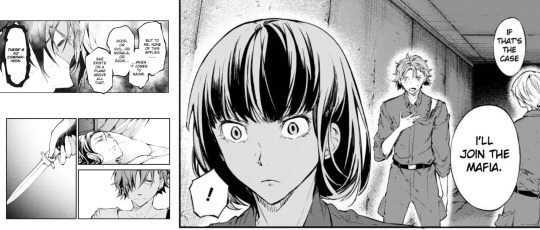
Moreover, although I am far from informed enough to speak confidently on this subject, I’d be amiss not to mention this meta written by bsd-bibliophile, which explains how the Port Mafia authors were faithful to the styles of traditional Japanese literature, whereas Armed Detective Agency authors were influenced by Western writing. Coincidentally, or perhaps intentionally, the comparison of Japanese versus Western traditions is the subject matter of “In Praise of Shadows” (1933), as I explained above; it would be a very clever reference to Tanizaki-sensei’s shifting interest if the theory that Tanizaki will switch sides ends up being correct.
In Conclusion
Despite knowing very little of Tanizaki’s backstory, and having limited on screen appearances of him in the story, much of what is established about Tanizaki can be traced back to his real life counterpart. We can also attempt to reverse engineer the character Tanizaki by making conjectures about his backstory and future character development based on what we know about Tanizaki-sensei. The theories that Naomi is an illusion, Tanizaki and Naomi are not real siblings, and that Tanizaki will switch sides are all supported by themes, motifs, and narratives that frequently appeared in Tanizaki-sensei’s writing. As such, I am very excited to see which theories will prove true, and how Asagiri-sensei will execute them in Bungou Stray Dogs going forward.
credits: bsd-bibliophile is a great resource for PDFs and ePubs of the works mentioned here, manga caps were scanned and translated by Easy Going Scans or Dazai Scans, highlighted passage in second visual is from the official Light Novel 3, left image in third visual is the first edition cover of Naomi novel
#bsd#bungou stray dogs#bsd naomi#bsd tanizaki#tanizaki junichirou#tanizaki naomi#bsd theory#bsd meta#bsd analysis#min i'll never write an essay of my own free will lu#clown emoji#i think i should get an extra lit credit just for writing this
366 notes
·
View notes
Text
what better way to procrastinate than to write random stuff
reviewing the works that the abilities were based on
Part 1: Armed Detective Agency
I just realized that I've finally read all the works attributed to the abilities of the author's BSD counterparts, at least for the ADA. I plan to do this for all organizations in the BSD universe so I can direct my reading and actually finish something HAHA
DISCLAIMER: I am not an expert on literature, let alone Japanese literature, and my short reviews are solely my opinion as a casual reader. These are all for fun so please don't take these so seriously!
Nakajima Atsushi
Ability: Beast Beneath the Moonlight
Original Work: Moon Over the Mountain
This short story has the vibes of a folktale but with existential dread sprinkled throughout. The prose is calm but the agony still reverberates. I liked this more than I though I would, perhaps because of how clean it felt. Honestly this would be one of the OG works I'd recommend to a BSD fan who wants to try classic Japanese literature.
Dazai Osamu
Ability/Original Work: No Longer Human
This is probably the one novel/work most BSD fans would pick up first - and for a good reason. The themes are pretty universal albeit heavy, the tone of the narrator throughout the entire novel is gripping, the translation by Donald Keene is very readable, and it's just in the most general sense a summary of Dazai-sensei's own life. The last point must be taken with a grain of salt, however, as he's a master liar - something you'll find out if you dig more into his life and other works. If you'd like to see depression in book form, this is for you.
Kunikida Doppo
Ability: Doppo Poet
Original Work: Doppo Collection (probably)
Here's a case of "I can't really find the original work so I'll be reviewing something else instead"
Reviewing: Those Unforgettable People
I chose to talk about this one since it's the one found in the Penguin Anthology. It's an interesting mix of forms: technically, it's a short story. However, the elements of poetry and even of the essay are present - mostly the latter, tbh. Of course the whole "ideal" thing is such a Kunikida-sensei thing that it appears it almost every story he wrote, yet somehow in this one you'll have to squint a little bit more to see it. The point of this story-essay-poem thing is at the very end (the first half is quite dragging imo) is what gives it a little oomph, but honestly I much prefer his other works (specifically Old Gen and Death).
Tanizaki Jun'ichirou
Ability/Original Work: Sasameyuki
You like a slow burn? You like pain? Familial drama? Maybe you'll like this. Maybe you won't. It's a mammoth of a book that feels like a series of extremely detailed telenovela episodes - not that it's necessarily a bad thing. I enjoyed it despite the length because the way it ends, although hardly strong at all, ties the themes and messages of the novel cleanly into a single scene.
Miyazawa Kenji
Ability/Original Work: Be Not Defeated by the Rain
It's a poem every Japanese elementary student would know. The message and style is so simple yet beautiful (I read Sulz's translation). It's joyful and so sunny... until I read the background on it. I cried over his work. Again. (Night on the Galactic Railroad PLS) Man I just love this author so much. But I'm not really a poem person to begin with, so take this review with a grain of salt HAHA
Yosano Akiko
Ability/Original Work: Thou Shalt Not Die
The only complete translation I could find is written in painfully archaic English, so I won't comment on the style HAHA. But I do think the original was just as pointed in its words and message; its anti-war sentiments and middle finger to the Japanese emperor and military (at the time) so characteristically Yosano-sensei. It's sad she'd support WW2 later on - come on sensei WHY
Personally, however, I prefer her shorter poems, specifically the ones from River of Stars. But I'm not really a poem person to begin with, so take this review with a grain of salt HAHA
Izumi Kyouka
Ability: Demon Snow
Original Work: Demon Pond
It's been a while since I've read a play, and perhaps that's why I had a hard time getting through the first half - either that or it was quite lackluster as most of the actual story happens in the second half. Its influences from folktales and traditional Japanese theater (i.e. kabuki and noh) are very apparent - I wish I could have seen it instead of read it because of that. I think this is the first work of Kyouka's that I actually liked (I've read some of his short stories and one of his other plays) so I'll definitely recommend this one if you want to start with this author.
There's also a movie adaptation of it that I haven't watched yet (but I do plan to). I think it could be much better than just reading it as is because of the visuals and mood setting, but a review on that soon. Maybe.
Fukuzawa Yukichi
Ability: All Men Are Created Equal
Original Work: An Encouragement of Learning (Sec. 1-2)
I couldn't be bothered to read the whole thing, but the essence of the ability only comes from the first two sections (which I'll be reviewing).
It's an essay that imo serves as a good introduction to Fukuzawa's philosophy. His views and arguments are built primarily on morality with logic acting mostly as a way to expound on his points. It's interesting, nothing really new for a contemporary reader, but at least it gives a nice background on the changing environment during the early years of Meiji-era Japan. Of course there are personal biases here (specifically the one with China - one of the greatest criticisms against Fukuzawa, even though he was supposedly progressive for his time) but imo that reflects some views of many Japanese at the time - not that they're right, of course.
But what about our special non-gifted boi?
I guess let's look at what one of the episodes was based on instead lol
Edogawa Ranpo
Episode: The Murder on D. Street (S01E05)
Original Work: The Case on D. Hill
I will tell you now: they have almost NO similarities whatsoever. Doesn't mean it's bad tho...
Okay ngl I was pretty disappointed HAHA. It's the same type of disappointment I had with Poe's Murders on the Rue Morgue (which was ironically referenced in the story) but it at least had some sense to it. I blame myself for not seeing it coming tho, given that this story is very typical of Edogawa-sensei. If you do plan to read it, however, be warned that there are implicit (?) themes that may be uncomfortable for some readers (this warning applies to most of Edogawa-sensei's work not made specifically for children HAHA).
#bsd#japanese literature#dazai osamu#nakajima atsushi#kunikida doppo#edogawa ranpo#yosano akiko#miyazawa kenji#fukuzawa yukichi#tanizaki junichirou#izumi kyouka
46 notes
·
View notes
Note
Annon-Guy: Narmaya is the winner of the Samurai Showdown; GranBlue Fantasy Guest Character Poll.
So in that vein, how do you think Narmaya would do in Samurai Showdown, bringing in her Dual Stance Fighting Style mechanic from the GranBlue Fantasy Versus fighting games?
Honestly there's characters like Yoshitora Tokugawa and even Tachibana Ukyo who could draw almost as fast (if not faster in Ukyo's case) than Narmaya can. I'd also argue that Takane Hibiki from Last Blade 2 is also a worthy rival as well.
Rather than say it's something unique to "alternate her fighting style"... Samurai Shodown in particular is FAMOUS for having characters who CAN alternate their fighting styles.
Shura: The Path of the Noble Sword... this is most swordsman's default fighting style, and the one that most players would be familiar with.
Rasetsu: The Path of the Demon... this is the "EX Mode" or Alternate Fighting Style that we haven't seen since Samurai Shodown IV: Amakusa's Revenge. A more acute differentiation and comparison to this is the difference between Haohmaru and Rasetsumaru... or Ryu and Kage (Evil Ryu).
Guilty Gear is also famous for having EX Mode in its fighting styles...
In matter of fact, Sol Badguy fights "very similarly to Ky" in his EX fighting style (shooting long range Gunflames), and doing varied mixup kicks, like his "Breakdown Bandit Revolver" (where he does a low thumping kick that knocks people to the ground instead of kicking them away like a Normal Bandit Revolver). It's actually an Overhead mixup!
Most famous of Sol's EX moves is Tyrant Rave version Gamma... which is his "version" of Ky's Ride the Lightning Overdrive... only instead of flying inside a wall of lightning... Sol creates a trail of flames with a giant orb of fire in front!
Meanwhile, Ky's EX style resembles Sol's... Needle Spike is his version of Bandit Revolver (which later developed in to Foudre Arc), along with Grand Vapor Thrust, which is a crossup, much like Sol's original Gunblaze (which later became Night Raid Vortex in Guilty Gear Strive).
One of Ky's more famous EX moves is a mid-air version of Sacred Edge... imagine if Ky had the air hangtime to throw out a Durandal Call version of Sacred Edge... hoo boy, that would hit at long range!
Anyway... back on topic... Samurai Shodown has a lot of characters who can alternate their fighting styles.
Ukyo for example, had a lot of rapid-slash moves in his Rasetsu style, and he could even throw out a projectile with his sword swipes (which has much more range than Narmaya, believe it or not!).
Yoshitora's multi-hit "slashing command grab" actually works in similar fashion to Ukyo's move Sasameyuki (which is also a variant of Johnny's Level 3 Mist Finer by the way), but aside from that Yoshitora increases his strength based on how many swords he draws... if he manages to draw his 7th blade, he can kill his opponent with his Nodachi via the Butterfly projectile he can create with it.
Unlike the rest of the cast, Yoshitora 'technically' didn't exist in older SamSho games, so he didn't get a Rasetsu style... but: assuming he did... most likely (like Johnny) his draws would operate similarly to Trap Counters.
Meaning he would enter a stance, and if the opponent draws on him, he will draw faster and hit them as a COUNTER! (This is very similar to how some parries work in Guilty Gear titles, but is also similar to Reversal Edge and dodge traps in Soul Calibur). Johnny had an EX fighting style that was based around this concept as well.
Even Axl Low's "Heaven can Wait" and Justice' "S.B.T." behaved similarly... even Hakumen's famous "Zanshin" parry grab works similarly.
As for other characters, Haohmaru's Rasetsu style involves more close-range melee style attacks, meaning he has more command grabs, close range projectiles, and a very powerful Tenha Dankuu Retsuzan, which is basically an Upside-down Tornado flipping attack (which would either disarm an opponent or kill them outright!)
Still, that's not to say that Narmaya isn't interesting in that she can alternate her fighting stances on the fly... similar characters would be Litchi Fei Ling of BlazBlue, but also Wan Fu, whose fighting style changes depending on if he's holding his massive pillar or fighting bare-handed!
Well, in the grand scheme of things, you have to be somewhat familiar with Samurai Shodown's history to know all this, but I digress.
2 notes
·
View notes
Text
thinking about his snow/winter motif again. his ability name sasameyuki ("light snow") is not really referencing literal snow, it's referring to falling cherry blossoms that look like snow, which appear in the novel frequently. therefore, the illusion of snow + out of season snowfall.
so basically, I avoided using a lot of snowflakes in my blog aesthetics because his "snowflakes" are actually white cherry blossoms. which goes with what I said about how his "burning" motif seems out of place with his winter theme, but in reality it fits perfectly.
5 notes
·
View notes
Text






«細雪» Sasameyuki
紙本着色 color on paper
2023
個人蔵 Private
表装・トリミング:村山秀紀(立入好和堂)
1 note
·
View note
Text
"The small house, now a museum, received its poetic name from Tanizaki Junichiro (1886-1965), who lived there with his wife, Matsuko, and her sisters from 1936 until 1943 and made it a setting for both his best-loved novel, The Makioka Sisters (Sasameyuki), which depicts the cultured and leisurely world of the prewar bourgeoisie, and for his last novel, The Maids. While signs throughout the house recall for visitors scenes from the earlier work, however, and promotional materials advertise it as 'the Makioka Sisters house,' there is little mention of the latter novel, which describes the same world in a lighter, comic mode and from the perspective not of the pampered family but of the maids who served them."
-Michael P. Cronin, "Afterword" to The Maids (1962) by Junichiro Tanizaki
#books#quote#fiction#tanizaki junichiro#tanizaki#japan#history#japanese culture#japanese literature#lit#literature
0 notes
Photo
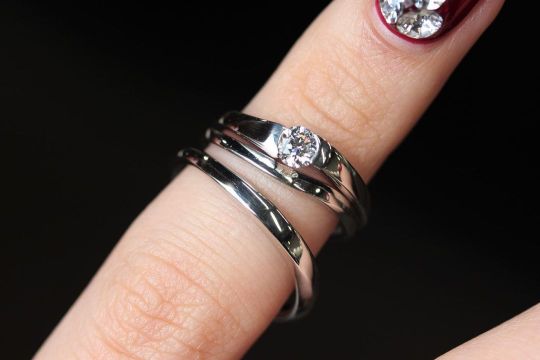
ブランド:葵山葵-AOIWASABI- ・ 婚約指輪: 笹雪-SASAYUKI- 結婚指輪: 細雪-SASAMEYUKI- ・ ご婚約指輪はダイヤモンドを留める爪がなく、 お洋服などに引っかかりにくいデザインです💎 ・ しっかりと幅を持たせているので 年齢を重ねても付けていただけます🎶 ・ ご結婚指輪は細身でシンプルなデザイン🧚 ・ 細身なのでご婚約指輪と重ね付けをしても ボリューミーにならないのがポイントです。 ・ 緩やかなウェーブがかかっているので 指を美しくみせてくれます◝✩ ・ お素材のご変更も可能ですので ご相談くださいませ🎶 ・ ・ #婚約指輪 #結婚指輪 #エンゲージリング #マリッジリング #葵山葵 #和風 #和婚 #和婚花嫁 #和 #指輪 #結婚 #入籍 #プレ花嫁 #婚姻届 #結婚式 #和装 #白無垢 #色打掛 #和婚をもっと盛り上げたい #神前式 #表参道 #京都 #結婚記念日 #結婚しました #プロポーズ #wedding #ring #ダイヤモンド #笹雪 #細雪 (雅-miyabi-表参道 (婚約指輪・結婚指輪・ダイヤモンド専門店)) https://www.instagram.com/p/CjsDbW8PRex/?igshid=NGJjMDIxMWI=
#婚約指輪#結婚指輪#エンゲージリング#マリッジリング#葵山葵#和風#和婚#和婚花嫁#和#指輪#結婚#入籍#プレ花嫁#婚姻届#結婚式#和装#白無垢#色打掛#和婚をもっと盛り上げたい#神前式#表参道#京都#結婚記念日#結婚しました#プロポーズ#wedding#ring#ダイヤモンド#笹雪#細雪
0 notes
Photo

細雪|ささめゆき|Lightly falling snow
321 notes
·
View notes
Photo







Sasame-yuki aka The Makioka Sisters, 1983, Kon Ichikawa
18 notes
·
View notes
Photo

22 notes
·
View notes
Text
2 notes
·
View notes
Photo








29 notes
·
View notes
Photo

I'm going through a very Japanese phase. I've been reading a lot of manga (apart from other types of comics) and watching animes these days because I like them and because I'm having some kind of reader's block. I start April wanting to read again, perhaps I'll get over with the block reading "The Makioka sisters". As a bookmark I will use this beautiful postcard that Magrat and Danvers sent me when they traveled to Japan. The cup is not very Japanese but the tea is sencha (Japanese green tea). Do any of you go through "theme" phases like me? Tell me! . I'd like to remind you that you can recommend me books, or movies... whatever you want. Happy Easter! . . Estoy pasando por una fase muy japonesa. Llevo una temporada que leo mucho manga y veo animes (aparte de otros tipos de comics) porque me gusta y porque tenía una especie de bloqueo lector. Empiezo abril con ganas de leer, a ver si lo consigo con "Las hermanas Makioka". Como marcapáginas voy a utilizar esta preciosa postal que me enviaron @magratajostiernos y @danversdixit cuando viajaron a Japón. La taza no es muy japonesa pero el té es sencha (té verde japonés). ¿Alguno de vosotros pasa por fases temáticas como yo? Contadme. . Aprovecho para recordar que podéis recomendarme libros, o películas... lo que queráis. ¡Feliz Pascua! . . . . . #Aprilreads #currentlyreading #JunichiroTanizaki #TanizakiJunichiro #MakiokaSisters #SasameYuki #Japanesewriters #Japanliterature #Japaneseliterature #springreads #lovelifeandkindness #bookrelated #books #literatura #libros #yoleoycomparto #booksofinstagram #bookwhorm #bookster #booklove #bookstagram #booklover #bibliophile #bookaholic #addictedtobooks #bookaddict #booknerd #IGreads #webtroverts (en Santander, Cantabria)
#tanizakijunichiro#webtroverts#lovelifeandkindness#aprilreads#japaneseliterature#bibliophile#japanliterature#sasameyuki#springreads#booknerd#bookrelated#booklove#currentlyreading#booksofinstagram#books#junichirotanizaki#addictedtobooks#makiokasisters#igreads#literatura#bookaddict#yoleoycomparto#libros#bookstagram#japanesewriters#bookaholic#bookwhorm#booklover#bookster
7 notes
·
View notes
Text
Artist: Bea LaRed
Day 24: SasameYuki : Snow that falls in silence
instagram
51 notes
·
View notes
